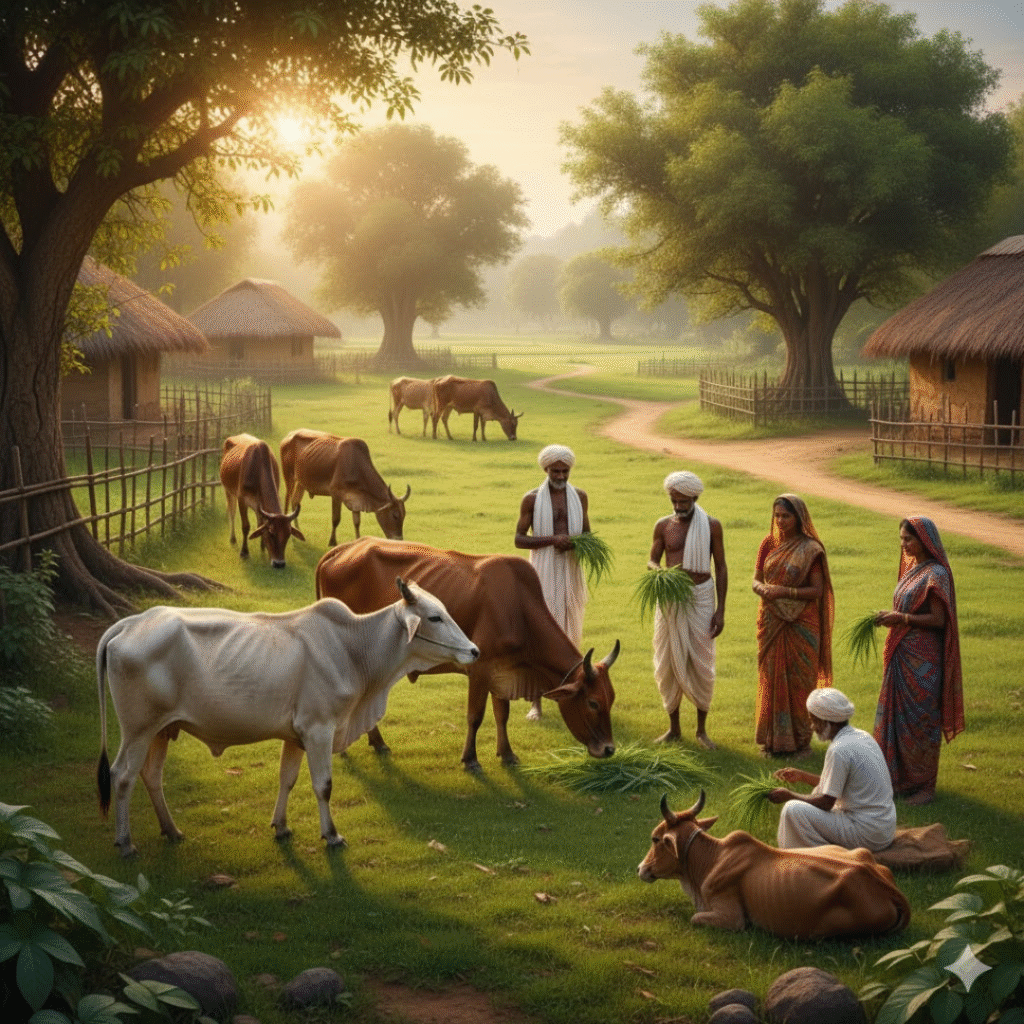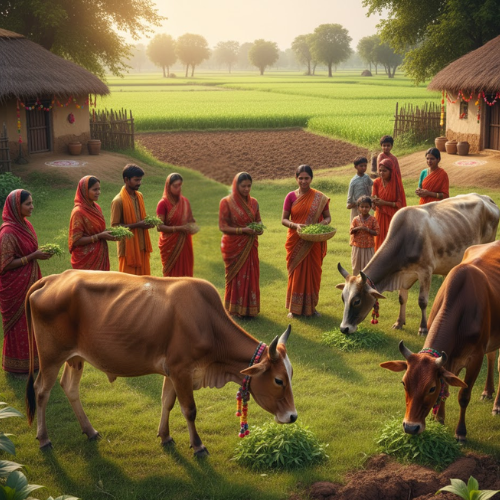GO Navaratri

Jay Go-Mata
India was once regarded as a world leader because of its indigenous culture, ethos, and ethics — principles that were practiced for centuries from the banks of the Sindhu to the Kaveri. One of the most prominent features of this universal influence was our unique way of life. The indigenous living practices of the Dravido-Aryan societies made them pioneers in almost every field.
According to Indian scriptures, the Mother Cow is called ‘Kamadhenu’, meaning “the Cow of Plenty,” who blesses her caretaker with all that he desires. When we examine the cow’s contribution economically, scientifically, and spiritually — from birth to death — we realize that “Kamadhenu” is not just a mythological idealization of the cow as a Hindu Goddess, but a fitting description of her immense role in sustaining life.
After attaining spiritual enlightenment, His Holiness Paramahamsa Prajnanananda Jee took up the divine mission of “Go-Seva.” According to him, the cow is not merely a religious symbol but the very symbol of our existence. In today’s restless world, true peace lies in serving God — and one of the purest ways to do so is by serving His divine creation, Mother Cow (Go-Mata).
Swamiji inspired youth to serve Go-Seva through five paths
Go Samvardhan
Protecting and nourishing cows to ensure their well-being daily.
Go Samprasaran
Spreading awareness about cows and their significance across communities.
Go-Adharit Vijnan
Promoting scientific knowledge based on cow products and their benefits.
Go-Adharit Sahitya
Creating literature focused on cows’ spiritual, cultural, and economic importance.
Go-Adharit Krushi
Encouraging agriculture practices based on cow products and sustainability.
Who We Are
Paramahamsa Jee taught that if we truly serve the cow as our Mother, there would be no need to fight for Go-Surakshya (cow protection). Go-Seva, according to him, is very simple — and if one sincerely follows these five principles, great wonders can be achieved.
He often quotes “Gābah Viśwasya Mātaram” — “The Cow is the Mother of the Universe” — emphasizing its spiritual, scientific, and economic truth.
Inspired by Swamiji’s divine guidance, a group of like-minded, devoted individuals from Odisha came together to form the Go-Seva Samiti. Since its inception, the organization has worked tirelessly across the state, following the five guiding principles of Go-Seva as directed by Swamiji.
A model Go-Seva Ashrama, named Guru Gobind Go-Seva Ashrama, was established in Puri, Odisha. With the blessings of Swamiji and the contributions of dedicated youths, this Ashram now functions as a model shelter home for street bulls and cows of Puri.
As per a Memorandum of Understanding with Puri Municipality, Guru Gobind Go-Seva Ashrama currently serves as a home for stray bulls and cows, providing them with care, nourishment, and safety.
What We Do
Aim
“If you serve Gomata with love and care, Mother Cow will automatically be protected.”
— Paramahamsa Prajnanananda Jee
Principles
Our work is guided by five pillars — Go Samvardhan, Go Samprasaran, Go Vijnan, Go Sahitya, and Go Krushi — forming the foundation of Go-Seva.
Activities
Under Swamiji’s spiritual guidance, awareness of Go-Seva reaches every corner through the Go-Jagaran Jatra, organized by the Odisha Go-Seva Samiti. Swamiji personally leads, inspiring communities and guiding volunteers with his divine mission.

International Go Navaratri
To spread the sacred message of Go-Seva across the world, the International Go Navaratri is organized in the Holy City of Puri, Odisha, by the Odisha Go-Seva Samiti and Guru Gobind Go-Seva Ashram under the direct guidance and supervision of revered spiritual leaders:
-
H.H. Nischalananda Saraswati Maharaj, Sankaracharya of Puri — Mukhya Margadarshak
-
H.E. Gajapati Maharaj Shri Dibya Singh Deb — Chief Patron
-
H.H. Paramahamsa Prajnanananda Ji — President, Mahotsava Samiti
The festival marks the revival of the ancient practice of worshipping and serving Mother Cow, one of the earliest forms of Navaratri, which had nearly faded from public consciousness.
Volunteers from 150 blocks across 30 districts of Odisha work tirelessly to make this divine celebration a grand success. Around 10,000 Go-Bhaktas from 750 Panchayats of Odisha, along with 5,000 delegates from across India and abroad, participate in this nine-day spiritual event. Nearly 1,000 saints and sages from different regions of the country bless the occasion with their presence.
Activities and Yajnans
The celebration features seven sacred Yajnans
, each carrying profound spiritual, cultural, and practical significance:
Gyan Yajnans
Spiritual discourses on Gomata, explaining her divine role, cultural importance, and guidance for compassionate service.
Dhyaan Yajnans
Meditation sessions focusing on Mother Cow’s energy, fostering inner peace, mindfulness, and spiritual connection.
Naam Yajnans
Continuous Akhanda Nama Sankirtan, along with a grand Nagar Sankirtan, engaging thousands in collective devotion.
Ghruta Yajnans
Fire ceremonies performed using only pure products from indigenous cows, symbolizing purity, abundance, and sacred offerings.
Arna Yajnans
Distribution of prasadam made from cow products to all devotees, promoting nourishment, sharing, and community bonding.
Vigyan Yajnans
Scientific workshops highlighting ecological, medicinal, nutritional, and economic benefits of cows and their diverse products.
Adhyaan Yajnans
Exhibitions demonstrating the cow’s economic, cultural, and agricultural significance, inspiring sustainable cow-based practices.

“Gābah Viśwasya Mātaram” — The Cow is the Mother of the Universe.
This profound message, supported by both spiritual wisdom and scientific understanding, forms the very heart of the Go Navaratri celebration. It reminds humanity that the cow is not merely a subject of religious reverence, but also a vital source of economy, ecology, agriculture, nutrition, and sustainability.
Mother Cow provides nourishment through milk, supports farmers through dung and urine for organic farming, and contributes to a balanced ecosystem. By protecting and serving her, humans embrace compassion, sustainability, and prosperity, ensuring the well-being of both society and nature.
Go Navaratri inspires every individual to recognize the cow as a living symbol of abundance, harmony, and life itself. It is a call to action — to honor, nurture, and safeguard Go-Mata, transforming spiritual devotion into practical service that benefits all of humanity.
